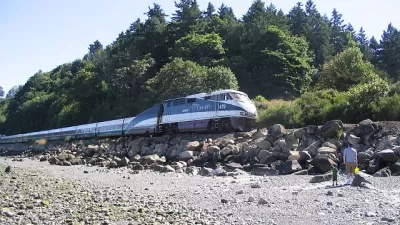A Friday evening collision between two Metro-North trains near Fairfield, Conn. injured 60 people, 5 of them critically. It's not known when service will be restored along the busiest train line in the nation.
Ravi Somaiya reports on the collision between two electrified Metro-North Railroad trains "near Fairfield, Conn., at the height of the evening rush on Friday", May 17. The collision between trains headed in opposite direction was the result of a derailment of the east-bound train.
Some 125,000 people travel each day in the affected region, according to Aaron Donovan, a spokesman for the Metropolitan Transportation Authority. “It’s the busiest train line in the nation in terms of passenger volume.”
“Damage is significant to both tracks and overheard wires,” Mr. Donovan said, adding that it would “take a substantial effort to repair.” He declined to predict how long those repairs might take.
Both the MTA and Amtrak said they could not say when service would resume.
However, according to the MTA service alert, "Regular service will operate between Stamford and Grand Central Terminal", whereas Amtrak service is much more severely disrupted.
"Amtrak service is temporarily suspended between New York and Boston", according to Amtrak's release, while "Amtrak service between New York and Washington is unaffected."
Train officials did not offer a reason for the derailment, though they reported that they "had found a section of rail on the eastbound track 'that was fractured at a rail joint'.”
Investigation being handled by the National Transportation Safety Board.
Earl Weener of the NTSB told CNN (see 2-minute video) that "the fracture could have been caused by the accident itself, or it could have been broken before the trains collided."
The New York Times article on May 18 included eyewitness observations from passengers in both the trains of the crash, and this video posted on Gawker captures the immediate aftermath of the collision.
FULL STORY: Trains May Not Run for Days in Crash Area

Maui's Vacation Rental Debate Turns Ugly
Verbal attacks, misinformation campaigns and fistfights plague a high-stakes debate to convert thousands of vacation rentals into long-term housing.

Planetizen Federal Action Tracker
A weekly monitor of how Trump’s orders and actions are impacting planners and planning in America.

In Urban Planning, AI Prompting Could be the New Design Thinking
Creativity has long been key to great urban design. What if we see AI as our new creative partner?

King County Supportive Housing Program Offers Hope for Unhoused Residents
The county is taking a ‘Housing First’ approach that prioritizes getting people into housing, then offering wraparound supportive services.

Researchers Use AI to Get Clearer Picture of US Housing
Analysts are using artificial intelligence to supercharge their research by allowing them to comb through data faster. Though these AI tools can be error prone, they save time and housing researchers are optimistic about the future.

Making Shared Micromobility More Inclusive
Cities and shared mobility system operators can do more to include people with disabilities in planning and operations, per a new report.
Urban Design for Planners 1: Software Tools
This six-course series explores essential urban design concepts using open source software and equips planners with the tools they need to participate fully in the urban design process.
Planning for Universal Design
Learn the tools for implementing Universal Design in planning regulations.
planning NEXT
Appalachian Highlands Housing Partners
Mpact (founded as Rail~Volution)
City of Camden Redevelopment Agency
City of Astoria
City of Portland
City of Laramie



























